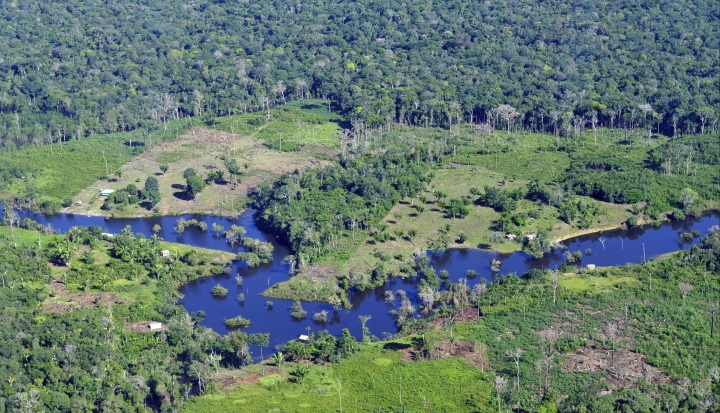Planes, trains, and automobiles may come in handy while seeking God in far-off places, or even close to home. Here are five spiritual detours to satisfy a restless heart.
One of my favorite family vacation memories consists of a station wagon breakdown on the side of the road somewhere in Georgia. My mother scooped peanut butter out of a jar for five cranky kids and prayed that the man who took my father to get gas was a trustworthy soul. (He was, and we drove off well-fed and less cranky, with my mother thanking Jesus, Mary, and Joseph.) The funny thing is, I have no memory of where we were going on that trip; I only remember the experience of God in the car and in the man who saved us from despair.
St. Ignatius of Loyola taught that the first key to a healthy spirituality is to find God in all things. If we take Ignatius’ wisdom to heart, we could say that every journey is a spiritual journey. As St. Joseph Sister Sallie Latkovich of Catholic Theological Union (CTU) in Chicago says, “Anytime anyone sets out from home, it’s a time of rediscovery. Whether it’s a day trip or a pilgrimage, near or far, a journey is always an opportunity to discover God and oneself in new places and new things.”
Latkovich, director of Bible study and travel programs at CTU, gives the example of a recent train trip home from Chicago’s O’Hare International Airport, when she met a homeless man who offered to help with her luggage. “It was a lovely encounter,” she says. “If you are open to it, you can see God in all people and places.”
It is true that we chance an encounter with God each time we step foot outside of the front door. But there are also some tried and true ways for people looking to get a little face time with the Alpha and Omega.
Roman Catholic holiday
This seems obvious: If you want to meet God head-on, go to the so-called “thin places”—where the space between heaven and earth collapses. No one knows precisely where the term “thin places” originated, but it seems to have its roots in Celtic spirituality. Many sacred sites around the globe seem to have just this quality.
My first experience with a sacred site was a pilgrimage to the Holy Land in the summer of 2012, organized by the Society of St. Teresa of Jesus. I was putting together a newsletter for the Teresian Sisters in Covington, Louisiana, when I saw their ad for a pilgrimage to the Holy Land. I instantly knew I had to go. I called my local Teresian, Sister Marina Aranzabal, and said: “I need to go on this trip! Sign me up!”
My financial picture wasn’t the prettiest, but the Holy Spirit told me I had to go, so I listened. I assumed that the Holy Spirit wanted me to spend my birthday on the Sea of Galilee, to be in the places where Jesus lived and breathed. But there was much more in store for me as I traveled around Israel.
It turned out that The Times-Picayune in New Orleans picked June 12, 2012, for its massive layoff day. I had worked for the newspaper for 25 years, and suddenly the owners were going digital and sending 200 employees packing. I was sitting in a hotel a block from the Sea of Galilee when I was fired. (Yes, an editor called me while I was on pilgrimage.) During that trip, the phrase “Come, follow me” took on a very new meaning.
And it was a beautiful journey. I prayed with 40 other pilgrims on the Mount of Beatitudes, on the Sea of Galilee, at the Western Wall in Jerusalem, and along the Way of the Cross. The Holy Land is filled with thin places, and some of those places are filled with God even in spite of the darkness that fills them, too.
Latkovich recently led a trip to Jerusalem, and she remembers visiting the Yad Vashem Holocaust museum. “It is very difficult to go there,” she says. “It is difficult to see what people have done to other people. I had a gut-wrenching response to what I saw, but I was mindful that God has the same gut-wrenching response.”
The Holy Land is but one of many thin places to which people journey to find new spiritual depth. Another is Assisi, especially now that our pope is named after the saint who lived in that Italian town. Of all the places she visited in Italy, Jewell Bayhi, director of religious education at Mary, Queen of Peace Catholic Church in Mandeville, Louisiana, remembers Assisi most fondly, calling it a “spiritual, humble place.”
She especially remembers sitting in St. Mary of the Angels Basilica in Assisi, the church located on the spot where Francis renounced the world and embraced poverty. “I realized the difference between a ‘trip’ and a ‘pilgrimage’ on that journey,” she says. “We were not just looking at things but reflecting upon them in light of what we read about St. Francis. It was awesome.”
Emily Susko of Baltimore had a similar experience during a pilgrimage to Lourdes, France, in 2008. “I’ve visited a lot of churches in Europe—in Germany, France, Italy, and Ireland. Most of the time I just feel like I’m with a bunch of tourists. But Lourdes, while I’m sure it had plenty of tourists, felt more like a group of pilgrims.” It was a place, Susko says, where she could focus “on how I could be more holy.”
She remembers many beautiful things about Lourdes, but the event that sticks in her mind the most—Lourdes is in the foothills of the Pyrenees—was the beauty of God’s creation. “I went on an afternoon hike on the closest mountain. At the top of the mountain, I had a lovely view over the area, and I could see snowcaps on nearby peaks,” she says. “I can’t figure out how to say this without sounding cheesy, but the natural world has always been a particularly wonderful place for me to experience God and appreciate God’s works.”
Hike up your spirit
Susko’s afternoon hike experience is far from unusual. In fact, many people use nature as their primary reason for not attending church, claiming, “I find God on the beach.” For many that’s true, and taking time in the great outdoors can certainly be a way to experience God.
Born and raised in the below sea level land of New Orleans, I always loved visiting the mountains and listening for God’s voice in the beauty of a tree-shaded trail or in the vast panoramas of the Blue Ridge Parkway.
My husband, children, and I were hiking up past Laurel Falls in the Great Smoky Mountains National Park several years ago when my 9-year-old daughter stomped her feet, saying, “I don’t want to hike anymore!” She walked ahead of me in a huff. Before I knew it, she stomped back: “There’s a deer up there.” I walked ahead and sure enough, a beautiful deer stood in the middle of the trail. God is full of surprises.
It’s those divine surprises that draw people to the Spirituality in Nature retreats led by Sacred Heart Sister Diane Roche, director of the Office of Justice, Peace, and Integrity of Creation at the Stuart Center in Washington. “It started as vocation outreach,” Roche says, adding that she and Sister Mary Pat White (“a mean biker”) were looking for ways to reach out to those who might be interested in vocations. As a result, she says, “We cooked up these retreats.”
The Spirituality in Nature retreats have included hiking and biking trips to the Black Hills of South Dakota and the White Mountains of New England. In July retreatants will travel to the Oakland, California area to find God in the nature of the inner city. “We thought we were doing these for young people, but there is a real hunger for these in people of all ages,” says Roche.
The retreats include prayer before the day begins “to set the tone for the day,” she says. Participants are given hints for paying attention to the movement of the Spirit in the repetitive action of hiking or biking.
In the evenings, “we gather the fruits of the day,” she says. “We might ask, ‘What face of God was revealed to you?’ God has many ways of talking to us.”
Roche’s favorite activity for finding God is biking. “There are shards of memory so deep,” she says. “The repetitive exercises help them come to the surface.” Sometimes the shards are cause for celebrating; sometimes they reveal the need of healing.
Although the Spirituality in Nature retreats are not open to the public (unless you have a connection to the Sisters of the Sacred Heart), Roche’s tips on finding God in nature can be used anywhere, anytime. It may be as simple as paying attention to the sky as you drive.
Julie and Mark Marchione and their family moved from Jacksonville, Florida to Petaluma, California several years ago, finding God as they crossed the country in their car. “We saw many incredible sunrises and sunsets in our travel,” Julie says, each one reminding her of God’s great beauty.
The sacred in the secular
God’s beauty is imbued not only in “holy” places or in nature, but also in the secular world. Some spaces are sacred because they hold profound meaning. They bring us into contact with the mystery of God.
When my daughters were about 5 and 6, they became fascinated with the story of Helen Keller. So I decided that our summer vacation to North Carolina would take a small detour—we traveled to Tuscumbia, in the northern reaches of Alabama, to visit Helen’s birthplace. We saw the water pump where Annie Sullivan furiously signed “water” into Helen’s open hand while water poured over it. It was powerful to stand there in that spot, to think about a young girl locked in darkness who suddenly could “see.”
Helen Keller’s house will always hold a special place in my heart. I suspect almost everyone has a “Helen” story, the story of a special place. For Deacon Eddy Beckendorf of the Archdiocese of New Orleans, that place is Arlington National Cemetery, and the Tomb of the Unknowns in particular.
In the mid-1980s, Beckendorf was traveling to Maryland on business and asked his wife, Susan, to fly from New Orleans to meet him so they could visit Washington. As a Vietnam veteran, he wanted to see the Vietnam Memorial. They made sure to arrive in time to witness the changing of the guard at the Tomb of the Unknowns.
“At the time we visited, there were the remains of soldiers from World War I, World War II, the Korean Conflict, and the Vietnam War in the tomb. After we were seated, I sat quietly in awe of the sacredness I found present,” not only in the tomb, he says, but in the way the members of the Third U.S. Infantry conducted their duty with such reverence.
“As the infantry entered the plaza to conduct the changing of the guard, I realized that I had been praying for and thinking about the families of the soldiers who lay in the tomb,” says Beckendorf. “A feeling of overwhelming sadness came over me as I grieved for the families that never had the opportunity to say goodbye.” Beckendorf felt a profound connection to the deceased and their families, and he gained a new appreciation, he says, for the “communion of saints.”
“In silence, Susan and I exited the Plaza of the Tomb of the Unknowns,” he says. They have returned twice, and it never fails to touch his heart.
Tourism with a heart
In December 2007, my parish hosted a group of parishioners from St. John the Evangelist Catholic Church in St. John, Indiana. They were members of a parish ministry called Faith Without Borders who came to help repair homes after Hurricane Katrina. They arrived the day after Christmas and slept on cots in our school’s cafeteria. They got up early every day for five days and traveled to the city to help gut houses, clean debris, and listen to the stories of loss.
Faith Without Borders is still going strong at St. John; in fact, it includes many mission opportunities under its umbrella. One of those is the Friends of the Orphans. As part of that ministry, parishioner WenDee Anderson took a trip to the Dominican Republic just after Christmas 2013 to visit an orphanage. “There were 32 of us on this trip, with 21 from my parish,” she says. “After Christmas is a good time to go.”
The team of volunteer tourists built pews, shelves, and benches. They also had fun playing volleyball with the kids, and they took time at night to reflect upon the meaning of all that they did during the day. “These trips are about God’s grace,” Anderson says. “It’s really a purely selfish thing. I get so much out of this. We see on these trips how much we touch someone’s heart.”
Why spend the holidays at an orphanage in another country? “God says we are here to help,” Anderson says. If we have time, or talent, or treasure to share, we just have to do it, she says, adding, “These children touch your heart.”
If you are looking for a way to serve others through volunteer tourism, opportunities abound. Becki Leedy of Simi Valley, California has led two youth groups to work with the Appalachia Service Project, an interdenominational ministry that aims to improve the living conditions of poverty-stricken people in Appalachia.
In 1997 she led a group to a small town in Kentucky. “On my second trip, in 2000, I was able to travel with my husband and my son, who had just turned 16, to Flag Pond, Tennessee. I was more prepared for the poverty we would see, but again not prepared for how I would be touched by the family” whose home they helped repair.
“I have found that giving money or goods as a donation is helpful and needed, but when you look into the eyes of the person you are serving,” she says, “God sets your heart on fire and you know you have looked into the eyes of Jesus.”
Spiritual “staycations”
With limited budgets and our busy schedules, it isn’t always so easy or even possible to take a pilgrimage to Assisi, visit Arlington, climb a mountain, or travel to the Dominican Republic. Depending on where you live, however, you can often find a spiritually enriching spot in your own backyard.
This country is full of cathedrals, basilicas, and shrines. I am blessed to live about 10 miles south of St. Joseph Abbey, a Benedictine monastery in St. Benedict, Louisiana that is a world set apart. I can stop in for vespers, walk the grounds, or visit the gift shop for some “monk soap.”
I’m sure you have somewhere sacred not far from you. Denise Lang of Katy, Texas, enjoys traveling to the San Antonio area, a short drive away, to visit the Franciscan Missions. (The California Missions, she says, are on her bucket list.)
“In Texas, when the Spaniards came to Mexico, the Franciscans came to evangelize the Indians who lived there,” she says. “There are five mission churches in San Antonio. One is just a wall, a shell. But there is one where you can go to Mass every day. It is very moving.”
She also enjoys the hill country of Texas, where the “painted churches” dot the hillsides. They were built by German and Czech immigrants who didn’t have the money for statues, she says, “so they painted statues on the walls.”
Nearly every city or town has a sacred spot with a story to tell. It may be as easy as checking with your local parish or diocese. I once took my sixth-grade religion class into our church to show them where a relic of Blessed Francis Xavier Seelos is buried under the altar. That quick trip opened up a whole new encounter with holiness.
If you are looking for a spiritually enriching journey, you can travel far or stay close; you can hike up a mountain or fly to the Holy Land; you can serve the poor or feed your kids peanut butter out of the jar. Just remember: God is in all things. Ignatius wouldn’t steer us wrong. Breathe it in, and enjoy the trip. As Sister Sallie Latkovich says, “When you go somewhere new or different, you encounter new epiphanies along the way.”
This article appeared in the April 2014 issue of U.S. Catholic (Vol. 79, No. 4, pages 12-16).
Image: Caitlyn Schmid















Add comment